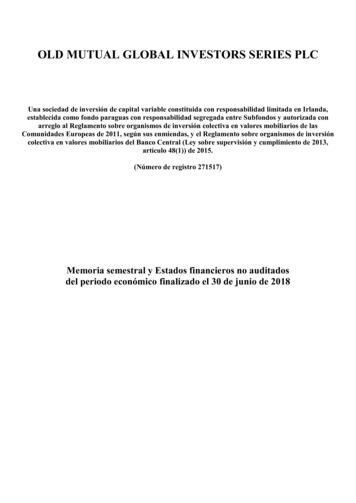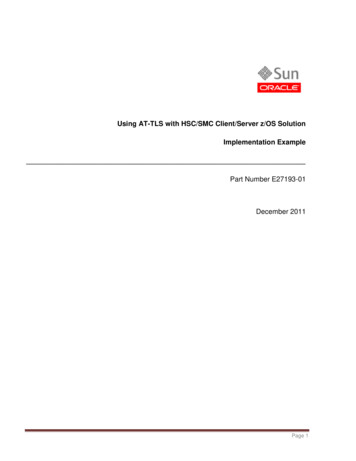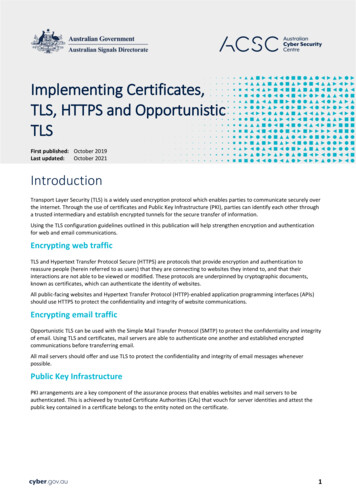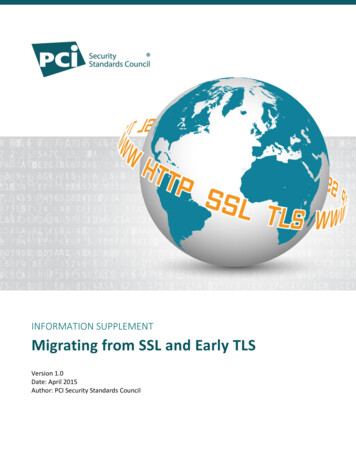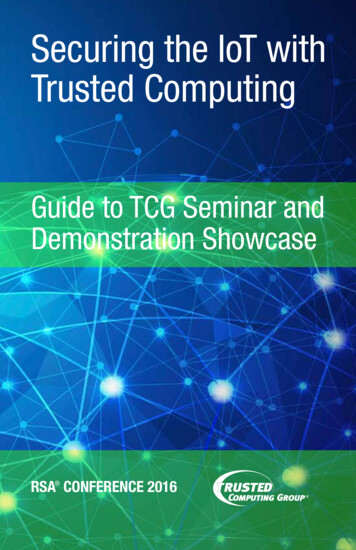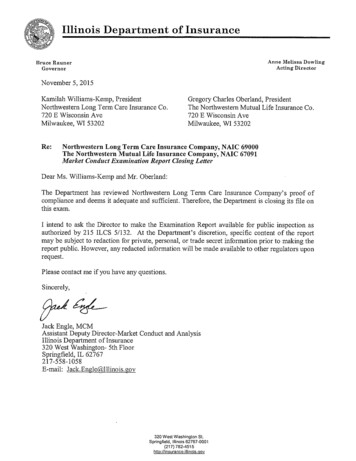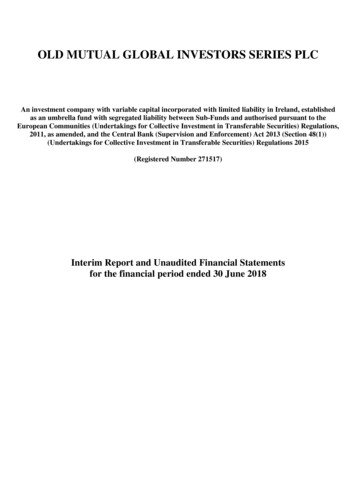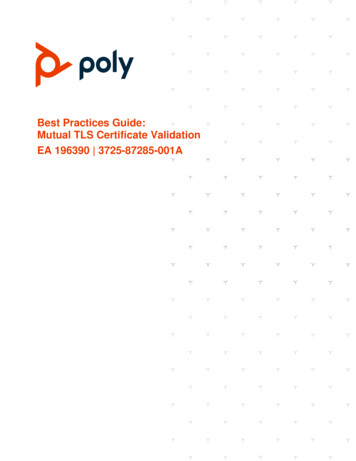
Transcription
Best Practices Guide:Mutual TLS Certificate ValidationEA 196390 3725-87285-001A
EA 196390 Best Practices Guide: Mutual TLS Certificate ValidationThis document applies to:All Poly, Polycom, and Obihai desk phones, conference phones,DECT mobile handsets, and voice adapters (ATAs).Poly devices are installed at the time of manufacture with a unique RSA certificate & key pair referred tohereafter as the "device certificate". Device certificates enable Poly and our partner services toauthenticate the device holding the certificate is what it declares itself to be. Device certificates arecommonly used in the following situations: Mutual TLS Authentication: Just as the phone will verify that the server is who it claims to be,device certificates allows a server to verify that a device is truly a Poly device and not a maliciousendpoint or software masquerading as a Poly device. This could be used for tasks like fileprovisioning or SIP signaling using TLS.Secure HTTP (https): Secures HTTP access to the web server on the phone at https:// IPADDRESS OF PHONE The web server is often used for configuration and troubleshooting activities.Securing API: Secures API communications and partner integrationsRestricting access: Restrict access to Poly cloud services such as ZTP, PDMS, or LensFor more detail on the device certificates themselves, please refer to Feature Profile 37148: DeviceCertificates on Polycom PhonesContentsDevice Certificates – Authenticating a Poly Device . 3Polycom Root and Intermediate Certificates . 3Certificate Revocation . 4Security Recommendations . 4Guidelines Suitable for all Partner Services . 4For Cisco/Broadworks Environments. 5For Apache Based Provisioning Servers . 6Password Based Provisioning Recommendations . 6Poly Security Center . 72
EA 196390 Best Practices Guide: Mutual TLS Certificate ValidationDevice Certificates – Authenticating a Poly DevicePoly devices can provide a certificate issued by the Polycom Root Certificate Authority. There are severalcomponents that should be checked by any service when authenticating a device based on thiscertificate:1) The Common Name (CN) - also represented as the "Issued to" attribute. Poly devices will usetheir MAC address as the CN allowing a one-to-one mapping of certificate to device. This uniqueidentifier is crucial to the security of any service as it will allow a means to restrict delivery of afile or service to any device requesting something for which its particular MAC is not entitled.Poly device certificates do not use Subject Alternative Name (SAN) fields to represent their MACaddress.2) The Issuing Authority - All Poly devices will be issued a device certificate by the Polycom RootCertificate Authority (CA). Much like any root CA, the Polycom Root CA has a public certificatethat will require installation on any server providing service to Poly devices. By trusting this root,you are extending trust to all devices who have been issued certificates by that root.3) The Validity Period - Poly devices will receive a certificate with a validity period of 15 years fromthe date of manufacture.Figure 1 - Viewing a Poly device certificatePolycom Root and Intermediate CertificatesThe Polycom Root CA has created several intermediate root CA's who perform the role of creating andsigning the certificates found on your Poly devices. When a Poly device provides its certificate, it will alsoprovide the chain of intermediate CAs that issued its certificate so that your service may establish thecomplete chain of trust from device up to the root.3
EA 196390 Best Practices Guide: Mutual TLS Certificate ValidationYou may download the Polycom Root and Intermediate CA certificates at:http://pki.polycom.com/pkiFigure 2 - The certificate chain of a Poly deviceCertificate RevocationIn the event a device certificate or root certificate must be revoked, the Certificate Revocation List (CRL)will be published at http://crl.polycom.com/crl.Poly devices support the Online Certificate Status Protocol (OCSP) and can check if a server certificatehas been enabled0 or 10When enabled, the OCSP retrieves information on whetherthe received server certificate is valid or revokedSecurity RecommendationsGuidelines Suitable for all Partner ServicesWhereas private key infrastructure (PKI) allows the authentication of a device, it is recommended thatmore than one layer of authentication be considered beyond who holds a certificate.1) Trust Specific DevicesThe most restrictive and therefore secure policy would be to know exactly which devices belongon your service and which do not. By creating an access control list (ACL) or allow list of MACaddresses, each requestor's certificate may be compared against that list and only when amatch is achieved will the device be permitted to request files or services.2) Verify the files requested belong to the requestorPoly devices are typically set up to request configuration files, and the primary means ofuniquely identifying the correct file is to include the MAC address of the device it belongs to inthe file name. When a request for a file is received, your service must check to see that the filerequested truly belongs to the requestor by matching the MAC address in the filename to theMAC address provided as the Common Name in the requestor's certificate. This will prevent4
EA 196390 Best Practices Guide: Mutual TLS Certificate Validationexploitation of your services where simply presenting a Polycom issued certificate wouldotherwise allow access to any file hosted by your service.3) Use Multi-Factor AuthenticationRequiring a username and password in addition to a valid certificate will greatly enhance thesecurity of your service. Ideally the password is unique to each device but even a commonusername and password can provide an additional hurdle for attackers. See the section titled"Password Based Provisioning Recommendations" for more information.For Cisco/Broadworks EnvironmentsThe Cisco BroadWorks DMS supports two types of file access control: username/password and MACbased.Prior to R22 & R21.sp1, should you choose the MAC-based file access, the requesting CPE's MAC addresswas pulled from the HTTP Request URI or from the HTTP headers without authentication. Because of thesecurity shortcomings to this method, BroadWorks introduced an improved mutual TLS authenticationin R22/R21.sp1 where the DMS extracts the requesting CPE's MAC address from the client certificatecommon name field (CN).To enable secure MAC-based authentication BroadWorks:1) Set Authentication Mode to "MAC-Based"2) Select the "Client Certificate" as the source3) Include the following regular expression as the MAC Address Format: .*([0-9a-fA-F]{12}).*Figure 3 – A completed MAC-Based File Authentication Page from the Broadworks Admin PortalFor the feature and server configuration details, see the XSP Client Certificates VerificationEnhancements feature description R21.0 supplied by Cisco.Note: If upgrade to R22 or R21.sp1 or later is not possible and you cannot implement mutual TLS / MACbased file authentication, then Cisco recommends using the username/password method rather thanthe less secure MAC-based authentication where the MAC address is taken from the HTTP Request URIor HTTP header.5
EA 196390 Best Practices Guide: Mutual TLS Certificate ValidationFor Apache Based Provisioning ServersApache directives can make use of variables to compare the common name from a Poly devicecertificate against the requested URL. Provided that all your configuration files contain the MAC addressof a phone, or that you enable this check only for select files, you can effectively block queries made bydevices or malicious users requesting files that do not belong to the requesting device. IfModule mod ssl.c VirtualHost default :443 ServerName example.comDocumentRoot /var/www/html#- Verify the client CN against the request URI.#- Allow only if the SSL CLIENT S DN CN (mac address) is a part of the request URI Directory "/var/www/html/polycom/configuration/ " If "%{REQUEST URI} -strcmatch \"*%{SSL CLIENT S DN CN}*\"" Require all granted /If Else Require all denied /Else /Directory Password Based Provisioning RecommendationsWhen using a username and password to protect provisioning server access, the first issue encounteredis how to safely install that username and password on the device. Ideally a unique username andpassword is used however that presents logistical issues that are more difficult to resolve and so use of acommon password may still be favorable and may be achieved using any of the following methods:1) At the DistributorMany partners already contract a distributor for out of box setup and configuration. Passwordsset up at this stage need never be shared with end users, however the primary negative to thismethod is that any device that is factory reset will lose the password and require a device RMAby the distributor.2) Poly's Zero Touch ServicesPoly provides both the ZTP and the PDMS zero touch service. Both of these services are wellsuited to installing a password before the device ever reaches your service. Any device that isfactory reset will also always return to the Poly service so RMAs would not be required.3) One-time Password Generation PortalFor partners not using either of the above services, any device that is factory reset or part of aBYOD offering requires the end user to enter the provisioning server address for your service. Apartner developed web portal that users must first log into could accept as input the MACaddress of a device and output a one-time password the user may enter into their phone at thesame time they enter your provisioning server address.Once the device reaches your service using the one-time password, you may serve only a smallconfiguration file that installs the primary common password and common provisioning address6
EA 196390 Best Practices Guide: Mutual TLS Certificate Validationprompting the phone to retry its provisioning requests. Now, since it is using the commonpassword, the true file set will be delivered enabling the phone to register for regular service.4) Use Strong Passwords and Change Them OftenPoly recommends enabling your devices to periodically poll your server for configurationupdates, even if it is performed only on a weekly basis. By creating two or more passwords thatgrant access to provisioning files, a new password can be inserted into configuration templateson a regular basis and wait for devices to pick up the changes before later retiring olderpasswords. This rotating window should be long enough that devices may be powered off for areasonable period of time without missing the window since if they do miss the update, you willrequire an onboarding service to enable them access again, such as described in items 1 through3 above.Poly Security CenterInformation security is a top priority for Poly across all products and services. Security bulletins andadvisories may be accessed from our security center rity-center.html 2021 Plantronics, Inc. All rights reserved. Poly and the propeller design are trademarks of Plantronics, Inc. TheBluetooth trademark is owned by Bluetooth SIG, Inc. and any use of the mark by Plantronics, Inc. is under license.All other trademarks are the property of their respective owners.7
hereafter as the "device certificate". Device certificates enable Poly and our partner services to authenticate the device holding the certificate is what it declares itself to be. Device certificates are commonly used in the following situations: Mutual TLS Authentication: Just as the phone will verify that the server is who it claims to be,


